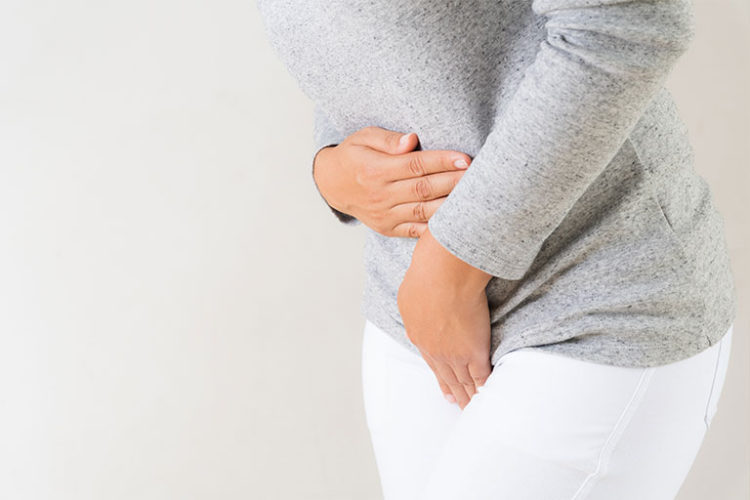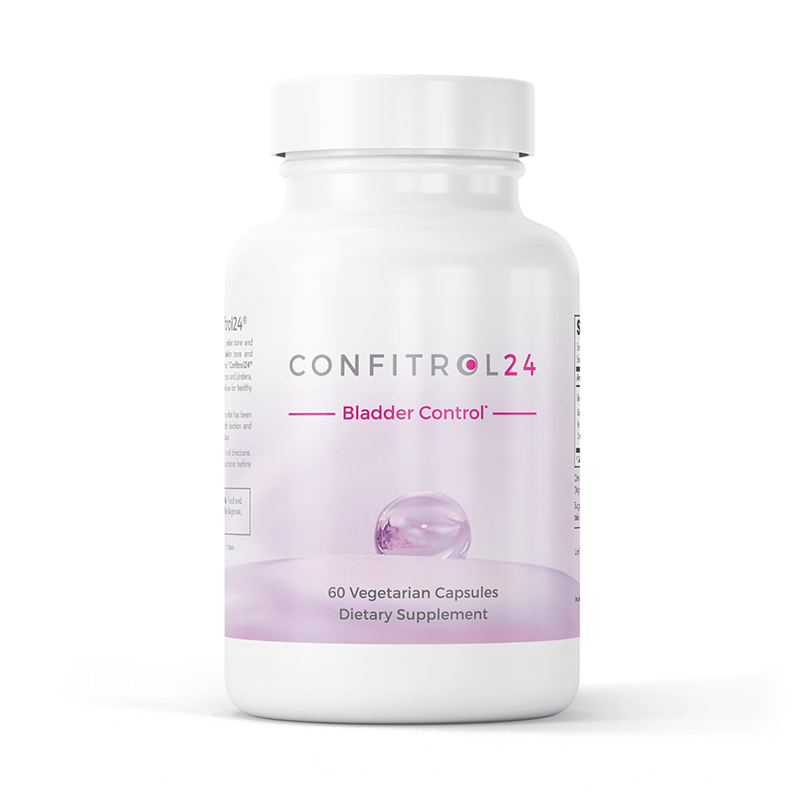Urinary incontinence is loss of bladder control[1]. It’s a common problem that’s highly embarrassing and can strike at, shall we say, the most awkward of times?
Symptoms of urinary incontinence can range from occasional leakage when you cough or sneeze (which is called ‘Stress Incontinence”) to a powerful urge to run to a toilet – to the point you may not even make it there in time.
Incontinence can destroy your quality of life.
So what can you do to manage urinary incontinence? You can start by looking at your lifestyle. Smoking increases your chances of embarrassing spillage, along with pelvic exercises that strengthen your bladder. A little (or a lot of) Confitrol24 can help fight urinary incontinence as well, and bring some resemblance of control back in your life.
Types of Urinary Incontinence
Urinary incontinence can happen for a variety of reasons. It can be small and temporary leakage or something so urgent you don’t make it to the toilet or anything between. Types of urinary incontinence include:
Stress Incontinence – This is a urine leak when you put pressure on your bladder, rather from coughing, sneezing, laughing, exercise or lifting a heavy object.
Urge Incontinence – When you have a sudden and intense urge to urinate and don’t make it to the bathroom in time. You may have to urinate often with urge incontinence, including at night, which can wreak havoc on your sleeping patterns and overall quality of life.
Overflow Incontinence – This is frequent or constant dribbling from a bladder that doesn’t seem to fully empty.
Functional Incontinence – Functional incontinence is either a mental or physical impairment that prevents you from reaching the toilet. You might have trouble unzipping your pants, for example, if you have severe arthritis.
Mixed Incontinence – As the name implies, this is a mix of different forms of urinary incontinence.
Risk Factors
So why is it that some folks get hit by urinary incontinence while other people seem to get spared? You’re at higher risk of the condition with the following factors:
Gender – Women are more likely to have stress incontinence than men because of pregnancy, childbirth, menopause and the structure of the female anatomy. Men are more likely to have urge and overflow incontinence if they have problems with their prostate.
Age – You’re at higher risk of urinary incontinence as you get older. You can thank weakening bladder muscles for that, along with changes to your bladder’s capacity.
Obesity – This puts extra weight on the bladder and muscles that surround it. In turn, this increases your risk of leakage when you cough or sneeze.
Smoking – You can count urinary incontinence among the many health risks of smoking.
Genes – You’re at higher risk of urinary incontinence if a family member has it too.
Also, sometimes urinary incontinence is caused by an underlying health concern or factor. These can include pregnancy, childbirth, menopause, changes from age, menopause, hysterectomy, enlarged prostate, obstruction and neurological disorders – among others – can all lead to urinary incontinence and various points in your life.
How to Stop Urinary Incontinence
Those are your risk factors for urinary incontinence. Now, how do you stop leakage[2] and bring a bit of normal to your life?
1 – Stop Smoking
Yup, this is easier said than done, we get that. But among other things, smoking strains your floor pelvic muscles, to say nothing about the other many health risks of smoking[3].
2 – Exercise Your Pelvic Muscles Each Day
This is another effective way to fight urinary incontinence, which often happens because of weakened bladder muscles.
You know how to strengthen muscles (hint, with free weights and resistance training). It’s the same with your pelvic muscles. How do you find your pelvic muscles? Stop your urine stream. Congratulations – those are your pelvic muscles. Now give them a little exercise[4].
A simple way to do this: sit comfortably and squeeze those muscles 10 to 15 times. Don’t tense up or hold your breath. Just squeeze, and as you get used to this, hold that squeeze a little longer.
Go ahead and add more squeezes after a few weeks, but don’t overdo it, and be sure to rest between each set. Note that pelvic exercises can take a few months before you notice a difference. But stay the course and stick with it – even when you see them beginning to work.
3 – Change Your Exercise Routine
We’ve already touched on the fact that lifting heavy objects can trigger stress incontinence. But it’s still important to exercise to keep your body in good form. Rather than sit ups and heavy weight training (both of which can strain the pelvis), try jogging, aerobics and pilates instead.
Pilates in particular may be a good option for people with urinary incontinence because they strengthen the core muscles, which can help reduce stress incontinence and related leakage when the bladder is put under pressure.
4 – Try Not to Lift
This is related to what we just talked about. Lifting strains the pelvic muscles, and you know what that means. Before you lift something, be it your kids, shopping bag or something else, tighten your pelvic muscles. You’ll find this easier to do if you’ve been strengthening them with the exercise we discussed earlier.
5- Try To Shed Excess Weight
This is up there with ‘try to quit smoking’ – it’s hard to do, but you’ll have less incontinence for your efforts. In fact, lose enough weight and your incontinence may go away completely. You can find your ideal weight with an online Body Mass Index (BMI) calculator. Generally speaking, you’re looking for a BMI between 18 and 25.
6 – Don’t Ignore Constipation
Straining to go Number Two can weaken your pelvic muscles. Think about putting more fiber in your diet if constipation is a problem. Exercise can also help. Speak with your doctor if you have ongoing constipation.
7 – Reduce Your Caffeine
No coffee? C’mon, that’s just cruel. We agree – but caffeine can irritate your bladder and, yup, coffee is the worst offender. Granted, we know that’s painful, but consider switching to decaf and/or water, herbal or fruit tea. You may find you’ll have less incontinence if you do.
8 – Drink Less Alcohol
Yes, we are officially taking the joy out of life. But bear with us on this – alcohol is a diuretic, which makes you pee more. See a pattern here? Cut down on alcohol and you’ll likely have less urinary incontinence.
9 – Drink More Water
Caffeine is bad and water is good if you have urinary incontinence. Unless your doctor tells you otherwise, you’re aiming for six to eight glasses a day. That may sound counter-intuitive, because you’re trying to pee less, but when you reduce fluids, you also reduce your bladder’s capacity.
As well, low fluid intake can also lead to constipation, or make it worse.
10 – Avoid ‘Trigger’ Foods
You probably know by now that acidic and spicy foods can irritate your bladder. These include curries and citric fruits.
Try Confitrol24
We’d be remiss not to suggest you try Confitrol24 if you have urinary incontinence. That’s because, well, it works, thanks to a unique blend of ingredients, called Urox, which strengthens pelvic function at the cellular level and which has shown in a clinical study to reduce bathroom visits and help patients with urinary incontinence sleep better through the night.
When you consider incontinence can destroy your sleep patterns[5], that is definitely a good thing.
What it Does:
- Strengthens the Bladder
- Reduces Dribbling
- Ends That Nagging ‘Urge to Go’
- Reduces Accidents
- Helps You Sleep Better
Why We Like Confitrol24: Confitrol24 has three ingredients that make it effective. These are Raw Horestail, Crevetox and Lindera Aggregata. Collectively they’re called ‘Urox’. An Australian study in 2013 found that volunteers who took it for 8 weeks had less urge incontinence, less leakage, fewer bathroom visits and better sleep.
It also comes with a 67 day money-back guarantee.
Try Confitrol24 if you’re looking for a natural way to fight urinary incontinence and to reduce the impact it has in your life. Combine it with the 10 ways to fight urinary incontinence that we’ve already discussed and you may soon find that relief so many people deserve.
FAQs About Urinary Incontinence
What is Urinary Incontinence?
Urinary Incontinence is loss of bladder control. It can be a primary disorder or caused by other health factor. It can be temporary, a life-long struggle or something in between. There really are no rules with urinary incontinence other than the fact that you should not ignore it.
Is it Dangerous?
On its own, urinary incontinence is probably not dangerous, although you should certainly speak with your doctor about it. Remember also that incontinence can also be caused by other, often urgent health conditions. These can include prostate issues, urinary obstruction and neurological disorders.
This makes it all the more important to speak with your doctor if you’re incontinent.
Why Do I Have Urinary Incontinence?
Possibly because of your genes, gender, lifestyle, age, or the health conditions we just talked about. Women are more likely to have urinary incontinence, although men are more likely to have urge and overflow incontinence than women if they have enlarged prostate.
Smoking and being overweight can also increase your odds of incontinence, as can a family history of it.
Will Incontinence Go Away On Its Own?
It might. But in many people it does not – particularly if you’ve struggled with it for much of your life.
How Do I Get Rid Of Urinary Incontinence?
You can reduce urinary incontinence a variety of ways. Start with your lifestyle. If you can stop smoking and lose weight, that alone should help reduce bladder leakage. You can also avoid foods and drinks that make it worse. These include alcohol, caffeinated drinks (yup, including coffee) and spicy and acidic foods like curry and citric fruits like lemons and grapefruits.
Pelvic exercises, like holding your urine flow for 10 seconds, 10 to 15 times per set may also help you with further bladder control.
What is Confitrol24?
Confitrol24 is a natural urinary incontinence supplement. It helps strengthen the bladder at the cellular level thanks to a unique blend of bladder-friendly ingredients (Raw Horsetail, Crevetox and Lindera Aggregata). This blend is called ‘Urox’ and it has shown in an Australian study to reduce urinary accidents, leakage, urge incontinence and bathroom visits.
You may also find it helps you sleep better.
Is Confitrol24 Safe?
Without knowing your medical background, it’s impossible to say Confitrol24 is completely safe. You’ll want to speak with your doctor before using it for the first time – especially if you’re currently taking medication or have a specific health concern or consideration in your medical history.
That’s something you should do before trying any health supplement for the first time, by the way. And you should speak with your doctor about urinary incontinence regardless.
With that said, Confitrol24 is a completely natural product and it’s made at a CGMP-compliant facility in the United States with strict health and safety regulations in place. You can also verify when and where the product was made.
Speak with your doctor before using Confitrol24. But unless there is something in your background that might cause a problem, it’s a good bet that you’ll be just fine.
When Will I See Results With Confitrol24?
You should have better bladder control with Confitrol24 in the first month, with best results typically in the three to six month range. Note that you’ll need to keep using it or your incontinence may return.
Is There Anything Else I Should Know About Urinary Incontinence?
Just that you’ve got plenty of company and it’s perfectly treatable, provided that you’re willing to step back and analyze the big picture. Watch your diet and your habits. Do the pelvic exercises we’ve talked about and think about giving Confitrol24 a shot.
You’ll be pleasantly surprised when these things all come together – and you’ll have a better quality of life as a result.
Improve your lifestyle further with our blog, “10 Lifestyle Changes To Improve Your Health.”
[1] https://www.mayoclinic.org/diseases-conditions/urinary-incontinence/symptoms-causes/syc-20352808
[2] https://www.nhs.uk/conditions/urinary-incontinence/10-ways-to-stop-leaks/
[3] https://www.cdc.gov/tobacco/basic_information/health_effects/index.htm
[4] https://www.nhs.uk/common-health-questions/womens-health/what-are-pelvic-floor-exercises/
[5] https://www.webmd.com/urinary-incontinence-oab/features/putting-an-overactive-bladder-to-bed







